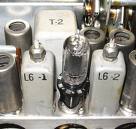|
TBY
The TBY is a UHF(in WWII terms) portable set
that operates on AM and MCW in the 28 to 80Mc band. It
puts out 1/4 of a watt from a push-pull Hartley
oscillator. The receiver is a regenerative type and
quite broad, which is appropriate, as the transmitter is quite
unstable.
The TBY uses a sectional whip antenna, with
differing numbers of sections being used for different
frequencies. In TBY through TBY-2, the whip was rigidly
mounted on the side of the transceiver with 2 mounts. In
TBY-4 and up, the whip mounts on a rotatable mount that allows
one to adjust the angle of the whip, so that you could lay the
rig flat on the ground and have the whip vertical. In
TBY-4 and up, there is also an SO-239 socket to allow the
connection of another antenna via a concentric(coaxial)
feedline.
There were three different power supplies
that could run the TBY. One was a dry battery pack,
another was a wet storage battery and vibrator, and another
was a rectifier for 110VAC input.
I recently did an experiment with my TBY,
setting it to each of the lowest channels and measuring the
frequency. I found channels 1-4 to be spaced on the
order of 300kc, and found the frequency to vary by over 100kc
as I adjusted the antenna loading. My conclusion is that
the TBY is best suited for communication with others of its
kind, and that trying to communicate with narrow-bandwidth
receivers will be quite difficult.
In an experiment with Joe N3IBX, about 7
miles away from me, I was able to successfully communicate
with him while he was using modern amateur equipment.
Since I could not tune my transmitter very precisely, I told
him to tune 29.0Mc plus or minus 100kc and call me where he
found me. This worked out fine. I was using a
coaxial sleeve dipole(vertical) at about 40 feet and Joe was
using a similar antenna.

|
| TBY-4 with AC Power
Supply |
I put my TBY in my car and hooked it up to
the car-mounted whip, and powered it with an inverter. I
recorded the signal at home on my RBK receiver in wide
bandwidth mode. This recording was made from a distance
of about 2 and 1/2 miles.
Click here to hear my TBY

|
| TBY-4 Antenna Mount
|
RADIOACTIVE PAINT ON TBX AND
TBY
Some of these sets had flourescent paint so
dials and settings could be read in the dark. These
paints are made up of a phosphor and radium to excite the
phosphor to glow. In most cases the phosphor has
degenerated so that the paint doesn't glow any more, but the
radium is still there. On the TBX, some models have
white numbers on the frequency dials and other labels, while
others are sort of orange. Both types can be
radioactive. The only way to know for sure is to check
with a Geiger counter.
To avoid rubbing the paint off onto my hands
or into the environment where it could be eaten or inhaled, I
have covered the radioactive paint with clear nail
polish. Other exposures due to proximity to the
equipment are not so hazardous, because the levels are low
enough to be safe at ordinary distances.
SCR-300/BC-1000
This is a quarter-watt FM transceiver on
40-48Mc.
This set is quite a challenge to get
working, as it is full of paper capacitors, some in rather
inconvenient locations. The culprits are the
Micamold-type paper caps in the same package as common mica
capacitors.

|
| BC-1000 with OE socket adapter
installed |

|
| BC-1000 IF transformer with shield
removed |
The photo above shows a new silver-mica
capacitor(red) installed in the IF can.
|